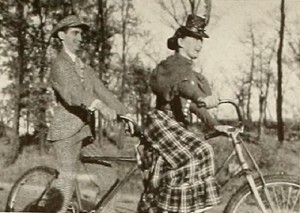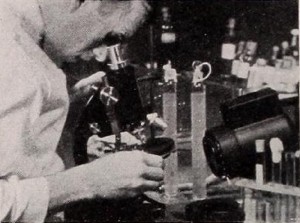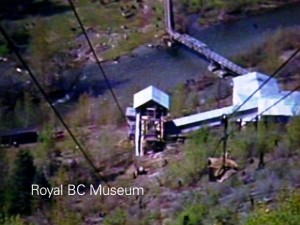"An outstanding example of what may be done with ordinary 16mm. equipment in the factory is to be found in The Story of Maytag, a black and white industrial film made by Fred Maytag, II. The problems of picturing the manufacture of washing machines in complete detail involved some tremendous lighting difficulties. Mr. Maytag handled these with ease, and throughout the film there is the conviction that the clear, clean photography scarcely could be improved. While the film was designed for use within the sales organization, the procedure of manufacture is so clearly pictured that it is not only comprehensible to the layman but interesting as well." Movie Makers, Dec. 1936, 548-549.
"BC Packers (Western Canadian Whaling Ltd.) whaling operations, based at Coal Harbour in Quatsino Sound. The whaling vessel Polar V leaves on a voyage. Preparation of equipment, including harpoons and harpoon gun. A whale is sighted, pursued and harpooned; it struggles, dies, and is flagged. The onboard scenes continue, showing more harpoon preparation, hunting and killing of whales. Whale is towed to Coal Harbour, where the flensing, butchering and processing of the carcass is shown. The Polar V sets out again; in very rough seas, another whale is pursued and killed. " (BC Archives)
The Western Canada Whaling Company was a sub-division of British Columbia Packers Limited.
The filmmaker is not identified. Film begins with the credit "British Columbia Packers presents..."

"Unsung Heroes, produced by The Calvin Company, has just about everything that a good industrial film ought to have. It is entirely in color, and the exposures are excellent, particularly in many shots of technical operations in the plant, which are ordinarily considered difficult. The subject embraces the manufacture, testing and rigid inspection of the component parts of a modern electric refrigerator. It is presented in a smooth, comprehensive way, with well delivered commentary and good incidental music,specially arranged to point up the action. The opening sequence, which shows a lip synchronized effect on a traveling outdoor shot, is unusually well done. However, the relation between this sequence and the rest of the film should have been more closely established." Movie Makers, Dec. 1941, 568.
"Unsung Heroes tells of the extreme care used in manufacturing electric refrigerators and of the exacting tests for durability, accuracy and silence of operation. Although the film is based on the familiar "trip through the factory" pattern, it has great interest for consumer audiences." Movie Makers, Jan. 1942, 8.

"An achieved simplicity in presenting a complex idea is the outstanding accomplishment that wins for the National Oil Products Company an honorable mention for its film. This picture presents the necessity for Vitamin "D" in the food of children and gives the highlights of preparing the Nopco product containing this essential food element. This picture, directed by Ralph Wechsler and photographed by Arnold M. Hill, ACL, follows the safely conventional presentation of industrial film messages in its continuity methods, its use of animated diagrams and its description of ultimate consumer usage. Working within this pattern, the makers of the picture have done extraordinarily well whatever they attempted. The continuity flows so smoothly as to be unperceived unless by a critically inclined observer; the animated diagrams are clear, well executed and strictly limited to the bare necessities of making the idea entirely evident; the photography is unexceptionable in nearly one hundred per cent of the film. This product of the joint efforts of an intelligent director, a very capable cinematographer and a fully cooperating industrial concern shows how perfect a practical film may be if real care is devoted to its making." Movie Makers, Dec. 1933, 522-523.
"Wire and Cable Manufacture, made by Robert F. Gowen, ACL, is a good example of what can be done with the presentation of heavy manufacturing processes. The many fine shots of large machines in motion as well as of rolling hot copper ingots were striking in their beauty. A careful record of the entire process of making a giant cable was worked out on short notice and was photographed in a short time. Many difficult lighting problems were overcome, and the result is an achievement that will do credit to the manufacturer's reputation and will add prestige to Mr. Gowen's cine fame." Movie Makers, Dec. 1935, 553, 555.
"Shows the process of gathering and using wool from the sheep to the mitten. The process includes shearing and spinning." Minnesota Historical Society.

"The town of Ymir and the nearby Yankee Girl gold mine. [COLOUR:] Mining concentrator building (with aerial tramway) beside the Salmo River. Mine site, high on mountainside; buildings; small electric train of ore cars; dumping tailings on hillside; dumping ore into aerial tramway; tramway buckets descending very steep hillside to concentrator, and emptying into hopper there. B&W: interior shots (some dark): ore on conveyor belt; refining processes [cyanidation and flotation]; etc. COLOUR: bridge across river for ore cars. B&W: interior of assay office; staff with instruments, performing tests, etc. COLOUR: May Day celebrations: baseball game; rock-drilling contest; presentation of prizes; May Queen pageant and crowning; children maypole dancing." (BC Archives)
The extant reel concludes with footage from elsewhere in the Kootenay Lake Region (Kootenay Lake, Nelson and Kettle Falls), which seems unrelated to the Ymir and... title. This item was part of an apparent series assembled by Morrell under the overall title British Columbia Sketches. Since the series title precedes the item title as shown above, this film was described by the BC Archives as British Columbia Sketches : [reel 8].
Total Pages: 4